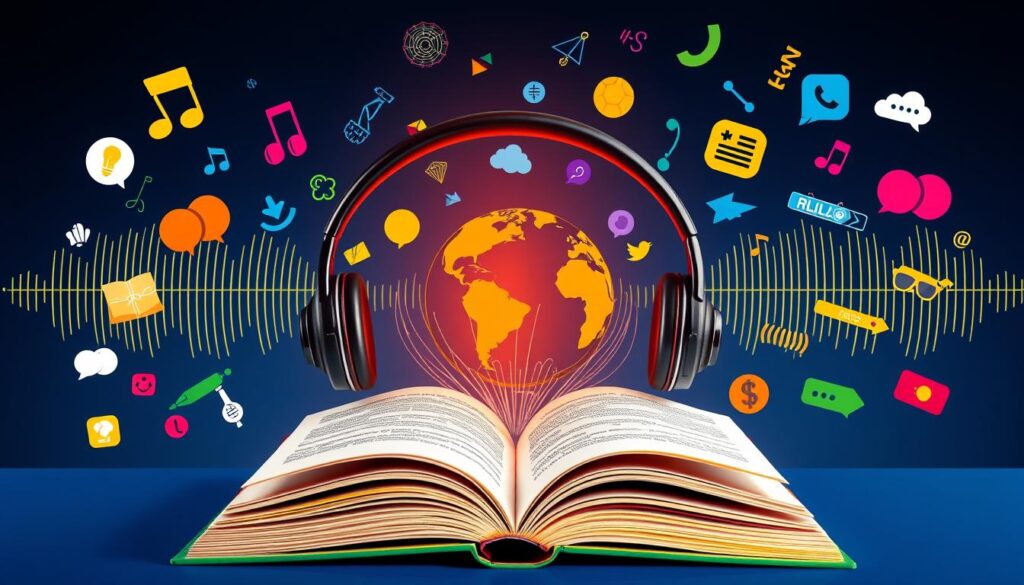“As an Amazon Associate I earn from qualifying purchases.” .
Imagine driving home after a long day, feeling tired from screens. Then, your car’s system starts reading your latest email. This is the power of text-to-speech technology, making words come alive through voice.
Text-to-speech is everywhere in our lives. It’s in our phones and audiobooks, changing how we get information. It’s not just easy; it helps those who find reading hard.
Speech synthesis has grown a lot from its early days. Now, systems can sound almost like humans. They help students, the visually impaired, and even create new voices for those who’ve lost theirs.
Let’s explore text-to-speech further. We’ll look at its history, uses, and what’s coming next. Whether you love tech or just want to know more, there’s something for you.
Key Takeaways
- Text-to-speech turns written words into natural-sounding speech
- It’s used in many areas, from podcasts to e-learning
- Today’s TTS lets you adjust speed and supports many languages
- It helps in education, accessibility, and business
- AI is making voices sound more natural and real
What is Text-to-Speech Technology?
Text-to-Speech (TTS) technology turns written words into spoken language. It’s changing how we get information. The market for this technology is expected to hit $6.52 billion by 2027.
Definition of Text-to-Speech
TTS is a system that makes text sound like it’s spoken by a person. It’s very accurate, getting it right 95-99% of the time. It works with different types of text, like e-books and web pages.
Brief History of Text-to-Speech Development
The start of TTS was decades ago. It has come a long way from robotic voices to almost human-like speech. Thanks to deep learning, it’s much better now.
Today, TTS supports many languages and accents. It’s used in education, for people with dyslexia or visual impairments, and in business. It helps students prepare for class and makes reading easier for those who struggle.
“TTS serves as an invaluable tool for individuals with disabilities, providing an accessible way to engage with text that might be hard to read through traditional means.”
As TTS keeps getting better, it will become even more important. It will change how we read and interact with written content in many areas.
How Text-to-Speech Works
Text-to-Speech (TTS) technology turns written words into spoken words. It uses Natural Language Processing and Speech Conversion. Let’s look at the main parts and methods that make this happen.
Key Components of TTS Systems
TTS systems use advanced algorithms and large datasets. These datasets include many languages, accents, and genders. For instance, a big dataset might have:
- Over 30 languages, from Arabic to Welsh
- Various regional accents (e.g., US, UK, Australian English)
- Equal representation of male and female voices
The Process of Text Analysis
Text analysis is key in TTS. It breaks down the text into smaller parts and understands its structure and meaning. This includes:
- Tokenization: Splitting text into words or phrases
- Part-of-speech tagging: Identifying nouns, verbs, adjectives, etc.
- Semantic analysis: Understanding the context and meaning

Speech Synthesis Techniques
After text analysis, speech synthesis techniques are used. Modern TTS systems employ advanced methods like:
- Concatenative synthesis: Combining pre-recorded speech segments
- Formant synthesis: Generating artificial speech sounds
- Neural network-based synthesis: Using AI to create highly natural speech
These methods, along with machine learning, make the audio output more lifelike and expressive. As TTS technology improves, we’ll see even more natural and varied speech conversion in the future.
Applications of Text-to-Speech
Text-to-speech (TTS) technology has changed how we use digital content. It uses Voice AI to make content more accessible and fun. This tool is key in many areas.
In Education and Learning
TTS is very important in schools. It helps students who struggle with reading by turning text into speech. It also helps language learners by teaching them how to pronounce words correctly. Tools like @Voice Aloud Reader support many file types, making learning easier.
In Accessibility and Inclusivity
For people with vision problems or reading issues, TTS is a big help. Apps like NaturalReader offer over 130 AI voices in 20+ languages. They also have OCR for text from images and PDFs.
In Business and Customer Service
Businesses use TTS for automated customer service and content. Voice AI makes talking to customers clear and quick. It makes work more efficient in many fields.
In Entertainment and Media
TTS is used for voiceovers and audio projects. Tools like Murf have over 120 voices for different projects. This makes creating audio fast and affordable.
| TTS Application | Key Benefits | Popular Tools |
|---|---|---|
| Education | Supports multiple file formats, aids language learning | @Voice Aloud Reader |
| Accessibility | Offers diverse voices, includes OCR functionality | NaturalReader |
| Business | Enhances customer service, improves efficiency | Speechify |
| Entertainment | Enables quick audio content creation | Murf |
Benefits of Using Text-to-Speech
Text-to-Speech (TTS) technology has changed how we read. It’s a Voice Generation tool that brings many benefits. Let’s look at the main advantages of Text-to-Speak systems.

Enhancing Productivity
TTS helps you do more at once. You can listen to texts while doing other tasks. This is great for busy professionals who need to stay updated but don’t have time to read.
Improving Accessibility
Text-to-Speech technology helps those with vision problems or reading challenges. The World Health Organization says over a billion people need assistive products. TTS makes digital content accessible to everyone, making our online world more inclusive.
Supporting Language Learning
TTS is a big help for language learners. It offers correct pronunciation and listening practice. Studies show that TTS helps users understand and remember text better. This makes learning new languages and improving speaking skills easier.
| Benefit | Impact |
|---|---|
| Productivity | Enables multitasking, saves time |
| Accessibility | Supports over 1 billion people with assistive needs |
| Language Learning | Improves comprehension and retention |
The Text-to-Speech market is booming, with a 14.7% growth rate from 2021 to 2028. This shows how widely TTS is valued in fields like education, business, and entertainment.
Popular Text-to-Speech Tools and Software
Text-to-speech technology has made huge strides. Now, many tools offer advanced speech synthesis and audio rendering. Let’s look at some of the most popular ones today.
Google Text-to-Speech
Google’s tool is a top pick for Android users. It has natural-sounding voices and supports many languages. The engine produces clear, crisp audio, making it a favorite among users.
Amazon Polly
Amazon Polly is loved for its realistic voices. It has a wide range of voice options and languages. With a 99.9% success rate in transcriptions, it’s a top choice in the industry.
Natural Reader
Natural Reader is great for personal use. It has a simple interface and customizable reading experiences. It supports many languages and lets users adjust reading speed for better understanding.
Microsoft Azure TTS
Microsoft Azure TTS is known for its advanced neural voice technology. It offers high-quality speech synthesis and supports many languages and accents. It can dictate at speeds up to 160 words per minute with 99% accuracy, making it a powerful tool for professionals.
| Tool | Key Feature | Best For |
|---|---|---|
| Google Text-to-Speech | Android Integration | Mobile Users |
| Amazon Polly | Lifelike Voices | Businesses |
| Natural Reader | User-Friendly Interface | Personal Use |
| Microsoft Azure TTS | Neural Voice Technology | Professional Use |
Comparing Text-to-Speech Providers
The Text-to-Speech (TTS) market is growing fast, expected to hit $9 billion by 2030. With many providers, it’s key to compare their features to meet your needs.
Voice Quality and Naturalness
Voice quality varies among providers. Amazon Polly has 60+ voices, while Murf.ai is known for its natural sound. Azure Text to Speech API works well with Microsoft tools, making it a great choice.
Supported Languages and Accents
Language support varies a lot. Murf.ai supports 20+ languages, and Synthesia supports over 130. Azure Text to Speech API leads with 140+ languages, followed by Google Cloud Text-to-Speech with 50+.
Pricing Models and Plans
Pricing models differ a lot. Many offer free trials or basic plans. Google Cloud Text-to-Speech has a free tier for the first million characters. Subscription-based models are common, with flexible plans like Murf AI and Play.ht.
| Provider | Voice Quality | Languages | Pricing |
|---|---|---|---|
| Amazon Polly | High | 39+ | Free tier available |
| Azure TTS | Excellent | 140+ | Free trial |
| Google Cloud TTS | Very good | 50+ | Free tier for 1M characters |
| Murf.ai | Natural-sounding | 20+ | Flexible plans |
When picking a Text Narration service, think about what you need. Some are best for voice quality, others for language variety. Look at pricing and features to find the perfect Voice AI for your projects.
Text-to-Speech for Accessibility
Text-to-speech (TTS) technology is key for digital accessibility. It turns written content into spoken words. This helps many users, making digital experiences better for all.
Supporting the Visually Impaired
For those who can’t see, TTS is like a digital voice. It reads out web pages, documents, and e-books. This lets them get information on their own, giving them more freedom online.
Benefits for Dyslexic Users
Dyslexic users really benefit from TTS. It changes text into audio, helping them understand complex stuff. About 80% of students with learning disabilities have trouble reading. TTS helps make things clearer for them.
Enhancing User Experience in Digital Products
TTS makes digital products better for everyone. It lets users change the speed and pick their language. The Text-to-Speech TTS Accessibility plugin supports over 51 languages. It works well with popular browsers and WordPress plugins, making it easy to use.
| Feature | Benefit |
|---|---|
| Multilingual Support | Caters to global audiences |
| Speed Control | Allows users to adjust pace for better comprehension |
| Browser Compatibility | Works across Chrome, Firefox, and Microsoft Edge |
| WordPress Integration | Enhances accessibility for WordPress sites |
Adding TTS to digital products makes them more welcoming. They help users with visual issues, learning disabilities, and those who learn better by listening. This technology is a big step towards making the digital world more accessible for everyone.
The Future of Text-to-Speech Technology
Text-to-speech technology is changing fast. This is thanks to better Natural Language Processing and Voice Generation. We can expect big changes in many fields.
Advances in AI and Machine Learning
AI and machine learning are making text-to-speech systems better. They’re making voices sound more natural and emotional. By 2030, the market is expected to hit $9.3 billion, growing fast.
Potential Impact on Different Industries
Text-to-speech will change many areas:
- Gaming: It makes games more real and interactive.
- Customer Service: AI helps make customer support better, like Erica at Bank of America.
- IoT: We’ll see more voice-activated devices, over 8.4 billion by 2024.
- Education: Tools like Synthesia make learning videos more engaging, getting over 30,000 views.
Ethical Considerations
As text-to-speech gets better, we face new ethical questions. We need to think about voice cloning and consent. Companies must use voice data and AI responsibly.
| Aspect | Current Status | Future Projection |
|---|---|---|
| Market Size | $3.8 Billion (2023) | $9.3 Billion (2030) |
| Voice Assistants | 1 in 4 U.S. adults use | Widespread adoption |
| Fraud Reduction | Up to 90% with voice biometrics | Enhanced security measures |
| Language Support | 60+ languages in real-time | Expanded language coverage |
How to Choose the Right Text-to-Speech Tool
Finding the right Text-to-Speak tool can be tough. There are many choices out there. It’s important to pick one that fits your needs for audio rendering. Let’s look at what to consider when making your choice.
Identifying Your Needs
First, figure out what you need. Do you want a tool that supports many languages? Or do you need it for business use? Think about these points:
- Language support
- Voice customization options
- Integration capabilities
- Export formats
Evaluating Features and Capabilities
Look at what different Text-to-Speak tools offer. Find ones with high-quality audio and natural voices. Here’s a look at some popular TTS providers:
| Provider | Languages | Key Features |
|---|---|---|
| Google Text-to-Speech | 40+ | Multilingual support, integration with Google products |
| Amazon Polly | 30+ | Neural TTS, multiple voice personas |
| Microsoft Azure TTS | 75+ | Wide language coverage, custom voice creation |
| IBM Watson TTS | 20+ | Voice tone adjustment, expressive speech synthesis |
User Reviews and Recommendations
Don’t ignore what others say. Read reviews to learn about real experiences. Look for comments on voice quality, ease of use, and support.
The best Text-to-Speak tool should match your needs and budget. Try free trials to test different tools. With careful thought, you’ll find the perfect audio rendering solution for your projects.
Limitations of Text-to-Speech
Text-to-Speech (TTS) technology has made big steps forward. It can now synthesize speech and narrate text in a more advanced way. But, these systems are not perfect yet.
Challenges with Pronunciation
One big problem for TTS is getting words right. Words or names that are not common often cause trouble. For example, the Standard (S0) pricing tier allows for 100 real-time speech to text requests at once. But, this doesn’t always mean perfect pronunciation.
Contextual Understanding Issues
TTS also has trouble understanding the context. The Standard (S0) tier lets you have up to 240 minutes of audio per file for real-time diarization. But, it’s hard for these systems to grasp complex texts or specialized terms.
The Role of Emotional Tone
Another challenge is getting the emotional tone right. The Standard (S0) tier can handle 200 transactions per second. But, it often misses the emotional depth that humans take for granted. This can make the speech sound unnatural or wrong for the content.
| Feature | Standard (S0) Tier | Free (F0) Tier |
|---|---|---|
| Concurrent Request Limit | 100 | 1 |
| Max Audio Length (Real-time) | 240 minutes | N/A |
| Transactions Per Second | 200 | 20 |
Even with these challenges, researchers keep working to make TTS better. For example, a Voice Cloning Challenge recently gave out $35,000 to the best entries. This shows how serious the industry is about improving speech synthesis.
Conclusion: The Value of Text-to-Speech in Today’s World
Text-to-speech (TTS) technology has changed the game in our digital world. Voice AI and speech conversion tools are changing how we interact with content and devices. The global market for speech and voice recognition is expected to reach $31.82 billion by 2025, growing at 17.2% annually.
Recap of Benefits
TTS brings many benefits across different areas. In customer service, AI systems answer questions with human-like voices. This improves satisfaction and cuts down on agent workloads. For content creators, generative AI makes audiobook production faster, saving time and resources.
Visually impaired individuals also gain from better accessibility. This makes digital spaces more inclusive for everyone.
Encouragement to Explore TTS Options
With digital voice assistants expected to hit 8.4 billion units by 2024, Voice AI is here to stay. Platforms like Google Assistant, Amazon Alexa, and Microsoft Azure TTS show the tech’s power. As 85% of users prefer voices that sound more human, checking out TTS options can improve your life and work in this changing world.
FAQ
What is Text-to-Speech technology?
How does Text-to-Speech work?
What are some common applications of Text-to-Speech?
What are the benefits of using Text-to-Speech?
What are some popular Text-to-Speech tools?
How do I choose the right Text-to-Speech tool?
What role does Text-to-Speech play in digital accessibility?
What is the future of Text-to-Speech technology?
What are some limitations of Text-to-Speech?
How does Text-to-Speech enhance productivity?
“As an Amazon Associate I earn from qualifying purchases.” .



